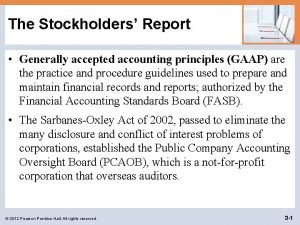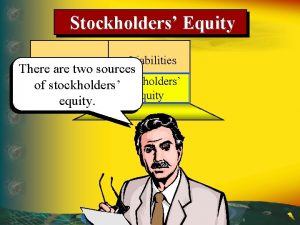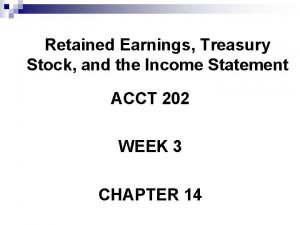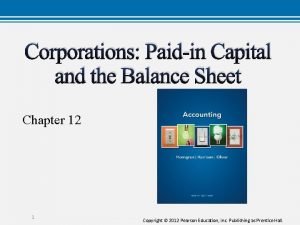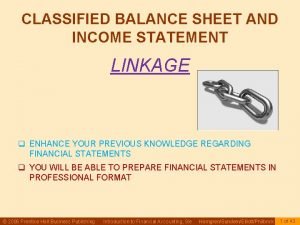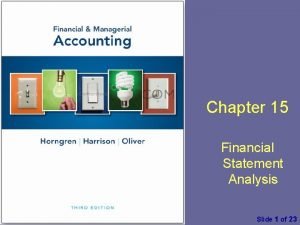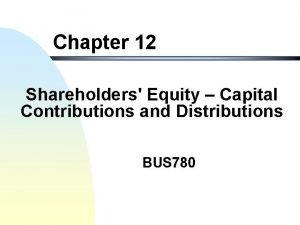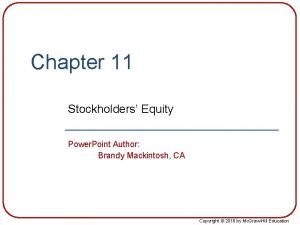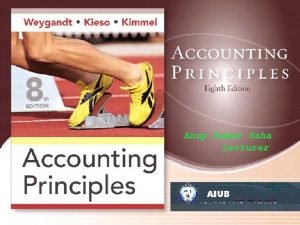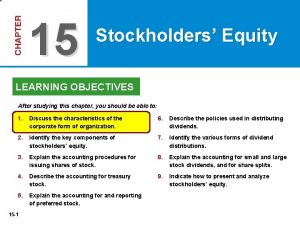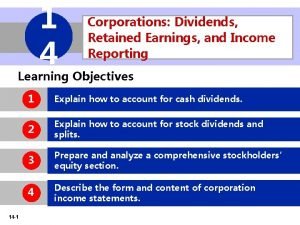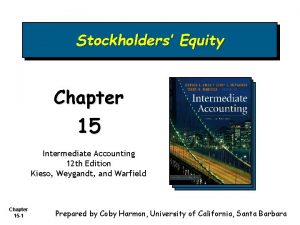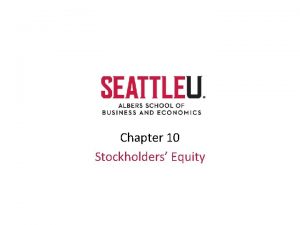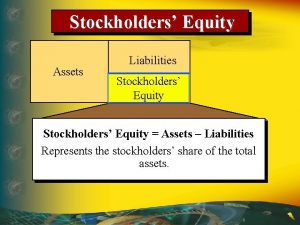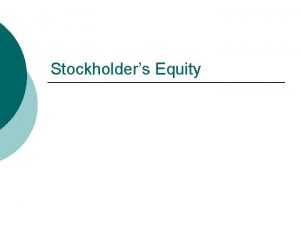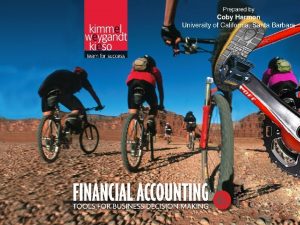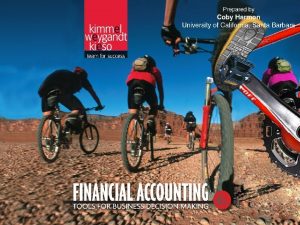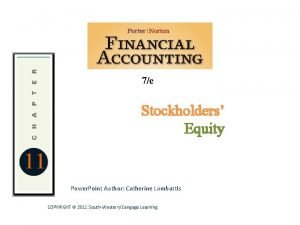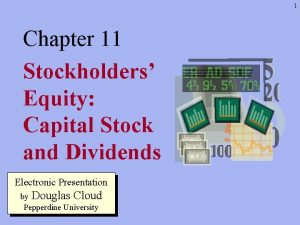Reporting and Analyzing Stockholders Equity Advantages mostly of














- Slides: 14

Reporting and Analyzing Stockholders’ Equity

Advantages (mostly) of Corporate Form • Corp has separate legal existence • Shareholders have limited liability • Transferable ownership rights—secondary markets • Continuous life • Professional management • Easier to raise large amounts of capital • Disadvantages—double taxation • Additional government regulation • Potential for managers to enrich themselves at the expense of some of the owners • See Illus. 11 -2 p. 541 for summary

Why issue C/S instead of debt? • Dividends to stockholders are discretionary; some companies never pay a dividend • May need to use both equity and debt • Publicly traded stock is easily transferable • The downside of stock—dividends are not deductible, control of corporation may be diluted, and EPS may be lower • See Illus. 11 -20 p. 562 for advantages of debt financing

Components of SE-see p. 548 • • • Paid-in Capital +Add’l Paid-in Capital Total Paid-in Capital + R/E Total Paid-in Capital and Retained Earnings -Treasury Stock TSE

Number of shares of stock • Authorized—number contained in Articles of Incorporation, maximum number of shares that can be issued • Issued—number of shares that have been transferred to shareholders at one time or another • Outstanding—number that are still in the hands of shareholders (does not include TS)

Par or Stated Value • Minimum amount that the shares will be issued for —with common stock, set very low • Has nothing to do with market value • If stock sold for price above par, the excess will be credited to Add’l PIC, PICIEOPV, or Premium account (credit) • Modern trend—no par or stated value—board of directors determines consideration for shares

Issuance of Common Stock • Issue 1000 shares of no-par common stock for $10 per share Cash 10000 Common Stock 10000 • Issue 1000 shares of $1 par common stock for $10 per share Cash 10000 Common Stock (1000 x 1) 1000 Paid-in Capital in Excess of Par-CS 9000

Common Stock v. Preferred Stock • Has voting rights • Greater risk • Right to share in dividends and proceeds on liquidation • See Illus. 11 -3 p. 542 for graphic of common stockholder rights • Does not vote • Has preference on dividends and rights on any liquidation • “near-debt”

Features of Pfd Stock • Dividends may be cumulative or non-cumulative. Cumulative—if preferred dividend not declared by board of directors, it must be “made up” before common gets a dividend. • Dividends in arrears—cumulative dividends not declared, not a liability, but requires note disclosure. • Other features, pfd stock can be participating, callable and/or convertible

Dividends • Cash Dividends • 3 dates—declaration date, record date and payment date (see p. 550 -551) • When declared, dividends reduce R/E (not an expense) and are a liability of the company • Stock Dividends— corporation issues add’l shares to shareholders. • Contrast with Stock Splits, e. g. a 2 -for-1 stock split—everyone owns twice as many shares after split

Cash Dividends - Entries • Cash dividends or R/E Dividends payable Declaration date • NER Record date • Dividends payable Cash Payment date

Stock splits/dividends Why? • • • Don’t use cash Increases the number of shares Should reduce the market price per share Make the stock more accessible/widely held Non-taxable

Treasury Stock • Company purchases its own stock, does not retire it • May do so for various reasons—pension plan, to reduce the number of shares outstanding, etc. • Entry Treas Stock xx Cash xx • Treasury Stock is not an asset-reduces SE, does not receive a dividend • Resales of TS—may involve Add’l PIC-TS

Ratios • Payout ratio—Cash Dividends/Net Income—What percentage of earnings goes to shareholders in the form of dividends? Why would a company prefer a low payout ratio? • Return on common equity (Net income – preferred dividends)/Avg. Common Stockholders’ Equity. Shows return on the stockholders’ total investment in the company. Prefer higher.
 Return on common stockholders' equity ratio formula
Return on common stockholders' equity ratio formula The two basic sources of stockholders equity are
The two basic sources of stockholders equity are Treasury stock income statement
Treasury stock income statement Return on common stockholders' equity ratio formula
Return on common stockholders' equity ratio formula Return on common stockholders’ equity
Return on common stockholders’ equity Return on common stockholders’ equity
Return on common stockholders’ equity Fiancial analysis chapter 15 pearson solutions
Fiancial analysis chapter 15 pearson solutions Fiancial analysis chapter 15 pearson solutions
Fiancial analysis chapter 15 pearson solutions Statement of stockholders equity example
Statement of stockholders equity example Large stock dividend journal entry
Large stock dividend journal entry Assets = liabilities + stockholders' equity
Assets = liabilities + stockholders' equity Diamond corp
Diamond corp Retained earnings ifrs
Retained earnings ifrs Retained earning t account
Retained earning t account The two main sources of stockholders' equity are
The two main sources of stockholders' equity are
